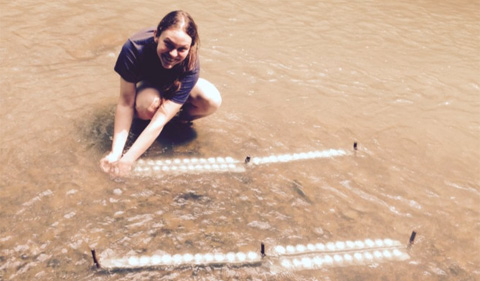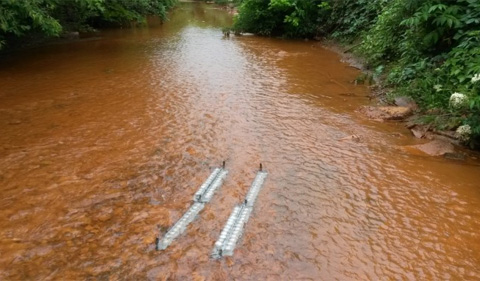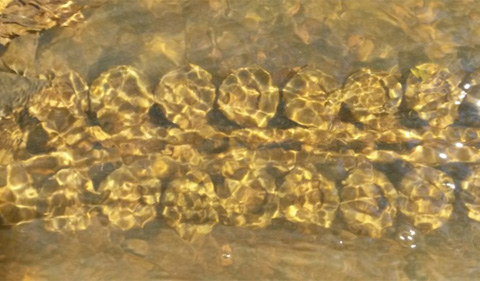By Sydney Dawes| Environmental and Plant Biology
Images of orange water poured out of Emily Keil’s phone as she discussed her current research. The orange is from the unusual amounts of iron that have built up in many streams in the Athens area over the years.
Keil, a graduate student in the Plant Biology M.S. program, has been analyzing the effects of acid mine drainage (AMD) on local streams. She received a Graduate Student Senate Original Work Grant in Fall 2015.
Keil randomly arranged over 1,000 cups in 16 different streams near the Athens area, and these cups contained either phosphorus, nitrogen, a combination of the two, or neither nutrient. Keil said she made sure to have a large sample size because “there’s always the issue of things being lost because of weather and vandalism.” She studied streams affected by AMD, streams that were unaffected, streams that were treated and had recovered, and streams that were treated but not fully recovered.
Keil said that this summer’s amount of rain brought complications to her project, such as having her cups covered in silt, having cups become buried in sediment, or having cups wash away in the streams. These instances were not major setbacks, though, according to Keil.
“As a stream ecologist, you have to expect something’s going to happen,” she said. Keil said she kept this in mind by placing the three replicates in each stream so that if one were to disappear, she could still collect data.
Profiling Bacteria, Fungi and Algae
To see the impact of AMD on the Appalachian area, Keil will use the Original Works Grant to run a total lipid profile to see the fatty acids of the biofilm (bacteria, fungi and algae) attached to the stream bottom, as well as to determine an increase or decrease in algal biomass. “It is really important to look at the different treatments used in different streams to see if there is an increase in biomass and if it’s statistically significant,” Keil said.
“My project is to look at nutrient limitation within the biofilm, and looking at the biofilm in streams that have been affected by AMD but are being remediated,” Keil said. “The best way to test to see if something is being limited by a nutrient is to add that nutrient, and if there’s an increase in the amount of mass, then you can fairly conclude that that is a limiting nutrient.” Keil said that many hypotheses point to phosphorus as a common limiting nutrient in streams affected by AMD.
Keil found inspiration for her current research during her undergraduate years, which were also spent at Ohio University. While working as a systematic student for Dr. Morgan Vis, Keil analyzed algae.
“I’ve always wanted to go into the ecology field. I wanted to be able to work especially with pollutants and doing recovery stuff,” she said. “When I was looking at grad school, she said that I could work with her ecology lab students,” Keil said. “I read a lot of the research, and a lot of the students in her lab have looked at different aspects of acid mine drainage. I wanted to look at how the recovery is going.”
Keil completed her fieldwork and is currently doing an enzyme analysis of 192 samples. “When the biofilm needs nitrogen, it will release nitrogen-acquiring enzymes,” Keil said. “They’re not going to release them if they don’t need it, because that requires energy. By looking at the enzyme activity, you can get an idea of what they’re needing and where they’re trying to get resources from.” She began her total lipid profiles, as well as an analysis of chlorophyll a, in December.





















Comments